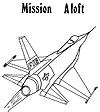 Jim Bumpas Games (1977, $6.00)
Jim Bumpas Games (1977, $6.00)
Designed by William Streifer
Components
Players 2 players or teams
Period Modern
Scale Tactical
Turn 30 seconds
Map 2 miles
Unit individual aircraft
Box ziploc
1 17x22" unmounted mapsheet
1 18 page rulebook
126 die-cut counters
10 double-sided plot sheets
Note The rulebook in my copy has a black line-art illustration on the cover, but a copy recently sold on eBay appeared to have a color cover.
Counter manifest
20 blue on blue (5 each of 4 different airplanes types)
106 blue on white (21 airplanes; 7 helicopters; 6 ships; 6 AA guns; 17 mobile AA; 18 SAM\'92s; 1 mobile radar; 6 trucks; 9 tanks; 9 APCs; 6 troops)
The designer says
“This game simulates some aspects of air warfare during the period 1960-1980. One player or team called the A-player must carry out one or more assigned air-to- ground attacks or a reconnaissance mission. The other player or team called the B-player employs interceptors and surface-to-air weapons to frustrate the A-player’s mission. The game consists of many scenarios drawn from Arab-Israeli, India-Pakistan, and Southeast Asian conflicts as well as hypothetical situations.”
The reviewers say
“Long sequence of play covering 13 separate operations ... Game map is hexes with imaginary cities, divided into radar search zones. Aircraft represented by silhouette counters with information gleaned from charts. Charts contain much info; e.g., fuel points, pilot points, ECM ratings, weapons effectiveness, counter measures, range, etc. ... [S]cenarios are fairly short and game can become somewhat complex, though not as much as it initially seems.” Richard Berg in S&T 63.
“[B]ears many of the worst characteristics of semi amateur games ... [the map] graphics have the appearance of being drawn hastily and with a blunt instrument ... some counters are smudged, and the silhouettes of some air and ground units are indistinct ... [S]ince surprise plays such an important part in missions of this type, there are elaborate rules for spotting and concealed movement ...
In scenarios where [defending aircraft] do not appear at the start of the game a farcical situation can develop with no units revealed on the board and neither side prepared to break cover first, so that an attacking aircraft may overfly a SAM-site without either side knowing a thing about it ... In combat resolution, allowances for the type and quality of weapon fired, the range, the target aircraft, Electronic Counter-Measures, pilot skill and previous damage are all brought together in a discordant clash of mathematical symbols to produce an adjustment to the throw of a single die used to resolve the attack, using either CRT I (1 = destroyed; 4-6 = no effect) or CRT II (a graded system of damage leading to destruction). If combat is unsatisfactory, movement is unacceptable; all aircraft are equally manoeuverable (though not all have the same speed) and accumulated damage has no effect until the aircraft is shot down.” Andrew McGee in The Wargamer 8.
Comments
A design with an ambitious scope that falls short of the mark. There are too many flaws for Mission Aloft to function as a decent simulation. Even if there were an enjoyable game here, the complex mechanics would seem to put it outside of today’s beer and pretzels realm.
The choice to go with an overly simple double-blind system is especially problematic. Defending aircraft are never hidden. Attacking aircraft are only required to be placed on the board if spotted by defending aircraft or ground units. However, ground units are initially hidden and cannot spot attacking aircraft until their location is revealed. A ground unit may voluntarily attempt to spot an attacking aircraft, but it must permanently reveal its location even if it is well outside of visual range of attacking aircraft.
The defender also has a long range radar search capability (which varies by scenario) which allows a certain number of mega-hexes to be searched each turn. The accuracy of the search is affected by the attacker’s ECM. The resulting “educated guessing game” feels more like Milton Bradley’s Battleship than a reflection of an actual radar net.
A note at the front of the rulebook indicates that ten more scenarios (11 through 20) for Mission Aloft would be available for $1 in early 1978.
Collector’s Notes
As has been mentioned in previous capsule profiles, old air combat board games don’t sell very well these days.
This makes the prices for Mission Aloft somewhat notable as they are significantly higher than other air combat games from the same era -- although the high prices might also stem from the fact that copies very rarely come up for sale. Boone 4th lists low/high/average auction prices of 22/65/40. In Boone 3rd, auction prices were 15/30/22 and sale listings were 65/65/65.
Other games highlighting modern tactical air-ground operations
Air and Armor (West End); Air Strike (GDW); FEBA (Close Simulations); Hornet Leader (GMT); Rolling Thunder (Commando Wargames, Group Three Games); Tac-Air (Avalon Hill); Thunderbolt-Apache Leader (GMT).
Capsule Profiles:
Back to Simulacrum Vol. 5 No. 1 Table of Contents
Back to Simulacrum List of Issues
Back to MagWeb Master Magazine List
© Copyright 2003 by Steambubble Graphics
This article appears in MagWeb (Magazine Web) on the Internet World Wide Web. Other articles from military history and related magazines are available at http://www.magweb.com